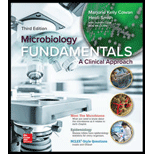
Microbiology Fundamentals: A Clinical Approach
3rd Edition
ISBN: 9781259709227
Author: Marjorie Kelly Cowan Professor, Heidi Smith
Publisher: McGraw-Hill Education
expand_more
expand_more
format_list_bulleted
Concept explainers
Question
Chapter 19.1, Problem 2AYP
Summary Introduction
To list:
The natural defenses present in the respiratory tract.
Introduction:
The respiratory tract is the most common place for infectious agents to gain access to the body. The microorganisms that are trapped causes involuntary responses such as coughing, sneezing, and swallowing which can move them out of sensitive areas.
Expert Solution & Answer
Want to see the full answer?
Check out a sample textbook solution
Students have asked these similar questions
What is the structure and function of Eukaryotic cells, including their organelles? How are Eukaryotic cells different than Prokaryotic cells, in terms of evolution which form of the cell might have came first? How do Eukaryotic cells become malignant (cancerous)?
What are the roles of DNA and proteins inside of the cell? What are the building blocks or molecular components of the DNA and proteins? How are proteins produced within the cell? What connection is there between DNA, proteins, and the cell cycle? What is the relationship between DNA, proteins, and Cancer?
Why cells go through various types of cell division and how eukaryotic cells control cell growth through the cell cycle control system?
Chapter 19 Solutions
Microbiology Fundamentals: A Clinical Approach
Ch. 19.1 - Draw or describe the anatomical features of the...Ch. 19.1 - Prob. 2AYPCh. 19.2 - List the types of normal biota presently known to...Ch. 19.2 - Prob. 1MMCh. 19.3 - List the possible causative agents, modes of...Ch. 19.3 - Identify the most dangerous cause of pharyngitis...Ch. 19.3 - Prob. 6AYPCh. 19.3 - Prob. 1NPCh. 19.3 - Prob. 2NPCh. 19.3 - Prob. 3NP
Ch. 19.4 - Prob. 7AYPCh. 19.4 - Compare and contrast antigenic drift and antigenic...Ch. 19.4 - Prob. 9AYPCh. 19.5 - Prob. 10AYPCh. 19.5 - Prob. 11AYPCh. 19.5 - Prob. 12AYPCh. 19.5 - Prob. 2MMCh. 19.5 - Prob. 4NPCh. 19 - Which of the following organisms is most...Ch. 19 - Prob. 2QCh. 19 - It has recently been established that the lower...Ch. 19 - Which of these microbes has an unusual, waxy, wall...Ch. 19 - What cell structure of Streptococcus pneumoniae...Ch. 19 - Prob. 6QCh. 19 - The betahemolysis of blood agar observed with...Ch. 19 - Would you expect the microbiome in the lung to be...Ch. 19 - In some diseases and outbreaks of respiratory...Ch. 19 - Prob. 10QCh. 19 - Prob. 11QCh. 19 - Prob. 12QCh. 19 - Which of the following infections often has/have a...Ch. 19 - Outline how a progression from influenza infection...Ch. 19 - Prob. 15QCh. 19 - Prob. 16QCh. 19 - Prob. 17QCh. 19 - Conducting your own research, describe the total...Ch. 19 - Watchful waiting is the recommended response to...Ch. 19 - Prob. 20QCh. 19 - Prob. 21QCh. 19 - From chapter 2, figure 2.18b. Although there are...
Knowledge Booster
Learn more about
Need a deep-dive on the concept behind this application? Look no further. Learn more about this topic, biology and related others by exploring similar questions and additional content below.Similar questions
- In one paragraph show how atoms and they're structure are related to the structure of dna and proteins. Talk about what atoms are. what they're made of, why chemical bonding is important to DNA?arrow_forwardWhat are the structure and properties of atoms and chemical bonds (especially how they relate to DNA and proteins).arrow_forwardThe Sentinel Cell: Nature’s Answer to Cancer?arrow_forward
- Molecular Biology Question You are working to characterize a novel protein in mice. Analysis shows that high levels of the primary transcript that codes for this protein are found in tissue from the brain, muscle, liver, and pancreas. However, an antibody that recognizes the C-terminal portion of the protein indicates that the protein is present in brain, muscle, and liver, but not in the pancreas. What is the most likely explanation for this result?arrow_forwardMolecular Biology Explain/discuss how “slow stop” and “quick/fast stop” mutants wereused to identify different protein involved in DNA replication in E. coli.arrow_forwardMolecular Biology Question A gene that codes for a protein was removed from a eukaryotic cell and inserted into a prokaryotic cell. Although the gene was successfully transcribed and translated, it produced a different protein than it produced in the eukaryotic cell. What is the most likely explanation?arrow_forward
- Molecular Biology LIST three characteristics of origins of replicationarrow_forwardMolecular Biology Question Please help. Thank you For E coli DNA polymerase III, give the structure and function of the b-clamp sub-complex. Describe how the structure of this sub-complex is important for it’s function.arrow_forwardMolecular Biology LIST three characteristics of DNA Polymerasesarrow_forward
arrow_back_ios
SEE MORE QUESTIONS
arrow_forward_ios
Recommended textbooks for you
- Understanding Health Insurance: A Guide to Billin...Health & NutritionISBN:9781337679480Author:GREENPublisher:Cengage
 Microbiology for Surgical Technologists (MindTap ...BiologyISBN:9781111306663Author:Margaret Rodriguez, Paul PricePublisher:Cengage Learning
Microbiology for Surgical Technologists (MindTap ...BiologyISBN:9781111306663Author:Margaret Rodriguez, Paul PricePublisher:Cengage Learning Human Physiology: From Cells to Systems (MindTap ...BiologyISBN:9781285866932Author:Lauralee SherwoodPublisher:Cengage Learning
Human Physiology: From Cells to Systems (MindTap ...BiologyISBN:9781285866932Author:Lauralee SherwoodPublisher:Cengage Learning


Understanding Health Insurance: A Guide to Billin...
Health & Nutrition
ISBN:9781337679480
Author:GREEN
Publisher:Cengage



Microbiology for Surgical Technologists (MindTap ...
Biology
ISBN:9781111306663
Author:Margaret Rodriguez, Paul Price
Publisher:Cengage Learning

Human Physiology: From Cells to Systems (MindTap ...
Biology
ISBN:9781285866932
Author:Lauralee Sherwood
Publisher:Cengage Learning